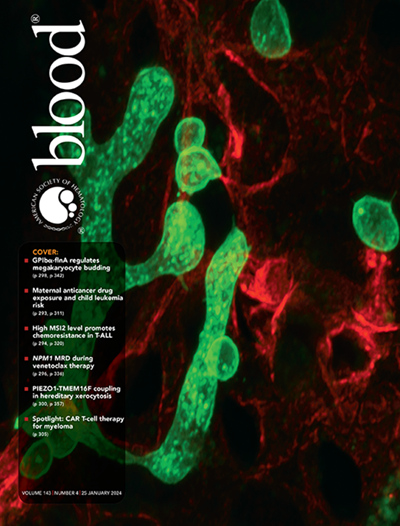---RGI-2001 for the Prophylaxis of Acute Graft-Versus-Host Disease Following Allogeneic HCT.
IF 21
1区 医学
Q1 HEMATOLOGY
引用次数: 0
Abstract
RGI-2001, a liposomal glycolipid that binds CD1d receptor of antigen-presenting cells, can activate invariant natural killer T cells and stimulate cytokine-dependent proliferation of regulatory T-cells (Tregs). This open-label, single-arm, multicenter phase 2b trial evaluated the safety and efficacy of RGI-2001 in combination with standard graft-versus-host disease (GVHD) prophylaxis in participants receiving myeloablative allogeneic hematopoietic cell transplantation (HCT) for hematologic malignancies. RGI-2001 was infused at a dose of 100 ug/kg for six weekly doses starting on Day 0 of HCT. The primary endpoint was grades II-IV acute GVHD by Day 100 after HCT. Forty-nine participants received RGI-2001 in combination with tacrolimus and methotrexate. RGI-2001 was well tolerated, with no serious infusion reactions. Sixteen participants experienced grade ≥3 treatment-related adverse events, with the most common being decreased appetite, leukopenia, thrombocytopenia and stomatitis. The estimated probability of grades II-IV and III-IV acute GVHD were 24.9% and 4.1%, respectively. Compared to controls from the Center for International Blood and Marrow Research Transplant registry, participants receiving RGI-2001 experienced superior clinical outcomes, including Day-180 grades II-IV acute GVHD-free survival (70.8% vs 50.7%, adjusted hazard ratio 0.45, 95% CI 0.30-0.68). Increasing NKT and Treg populations were observed after HCT, consistent with the proposed action of RGI-2001. In conclusion, RGI-2001 was well tolerated and was associated with low rates of acute GVHD and encouraging survival after myeloablative HCT. These results support strategies that target NKT and Treg cell populations to augment immunological changes in allogeneic HCT recipients. This trial was registered at www.clinicaltrials.gov as NCT04014790.——RGI-2001关于同种异体HCT后急性移植物抗宿主病的预防。
RGI-2001是一种结合抗原呈递细胞CD1d受体的脂质体糖脂,可以激活不变的自然杀伤T细胞,并刺激细胞因子依赖性的调节性T细胞(Tregs)增殖。这项开放标签、单组、多中心2b期试验评估了RGI-2001联合标准移植物抗宿主病(GVHD)预防在接受清髓异基因造血细胞移植(HCT)治疗血液恶性肿瘤患者中的安全性和有效性。RGI-2001以100 ug/kg的剂量输注,从HCT第0天开始,连续6周给药。主要终点是HCT后第100天的II-IV级急性GVHD。49名参与者接受了RGI-2001联合他克莫司和甲氨蝶呤治疗。RGI-2001耐受性良好,无严重输液反应。16名参与者经历了≥3级治疗相关不良事件,最常见的是食欲下降、白细胞减少、血小板减少和口炎。II-IV级和III-IV级急性GVHD的估计概率分别为24.9%和4.1%。与国际血液和骨髓移植研究中心登记的对照组相比,接受RGI-2001治疗的参与者有更好的临床结果,包括第180天II-IV级急性无gvhd生存率(70.8% vs 50.7%,校正风险比0.45,95% CI 0.30-0.68)。HCT后观察到NKT和Treg数量增加,与RGI-2001建议的行动一致。总之,RGI-2001耐受性良好,与低急性GVHD发生率相关,并促进骨髓清除性HCT后的生存率。这些结果支持针对NKT和Treg细胞群的策略,以增强同种异体HCT受体的免疫变化。该试验在www.clinicaltrials.gov注册为NCT04014790。
本文章由计算机程序翻译,如有差异,请以英文原文为准。
求助全文
约1分钟内获得全文
求助全文
来源期刊

Blood
医学-血液学
CiteScore
23.60
自引率
3.90%
发文量
955
审稿时长
1 months
期刊介绍:
Blood, the official journal of the American Society of Hematology, published online and in print, provides an international forum for the publication of original articles describing basic laboratory, translational, and clinical investigations in hematology. Primary research articles will be published under the following scientific categories: Clinical Trials and Observations; Gene Therapy; Hematopoiesis and Stem Cells; Immunobiology and Immunotherapy scope; Myeloid Neoplasia; Lymphoid Neoplasia; Phagocytes, Granulocytes and Myelopoiesis; Platelets and Thrombopoiesis; Red Cells, Iron and Erythropoiesis; Thrombosis and Hemostasis; Transfusion Medicine; Transplantation; and Vascular Biology. Papers can be listed under more than one category as appropriate.
 求助内容:
求助内容: 应助结果提醒方式:
应助结果提醒方式:


